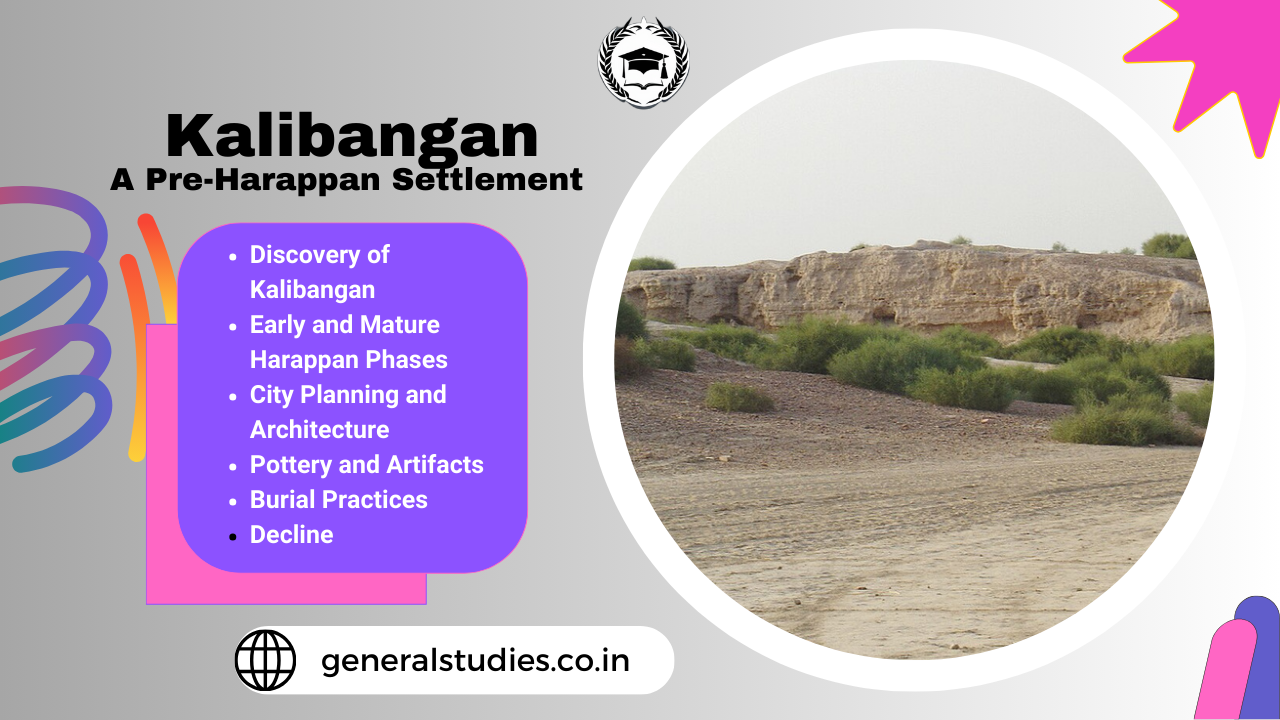Table of Contents
Location of Kalibangan Harappan Site
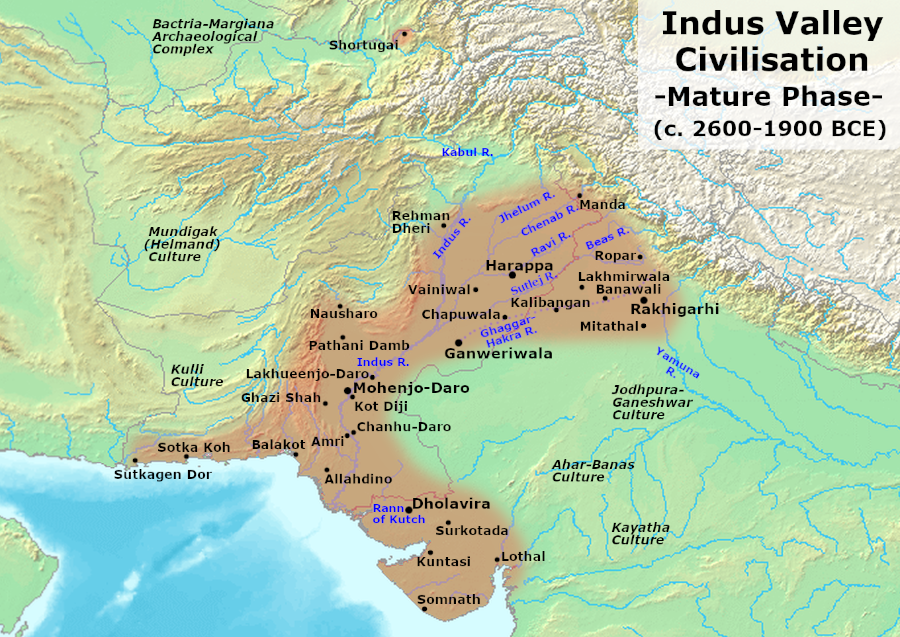
Kalibangan is an archaeological site in Rajasthan, which offers critical insights into the Harappan and pre-Harappan civilizations. It is located along the southern banks of the now-dried Ghaggar River (ancient Sarasvati) in the Hanumangarh district. Kalibangan provides a fascinating glimpse into the ancient city planning, religious practices, and early agricultural techniques of one of the world’s oldest urban civilizations.
Kalibangan Meaning
The name Kalibangan is derived from two words in Rajasthani: ‘Kali’ meaning “black” and ‘Banga’ meaning “bangles.” Numerous black terracotta bangles were found at the site during excavations.
Discovery of Kalibangan
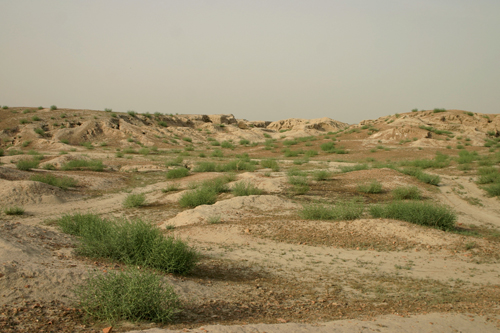
Image Source: ASI
Discovery of Kalibangan
- Initial Discovery by Luigi Pio Tessitori:
- Kalibangan was first identified by Luigi Pio Tessitori, an Italian Indologist, in the early 20th century (1887–1919).
- Tessitori’s observations led him to contact Sir John Marshall of the Archaeological Survey of India (ASI). However, at that time, the importance of the site remained underappreciated, as the focus was primarily on excavations at Harappa.
- Recognition of Harappan Significance:
- Following India’s independence in 1947, major Harappan sites like Harappa and Mohenjodaro became part of Pakistan, prompting Indian archaeologists to search for significant Indus Valley Civilization sites within India.
- Amlanand Ghosh, then Director General of the ASI, was the first to identify Kalibangan as a potential Harappan site.
- Excavation Led by B. B. Lal:
- From 1960 to 1969, under the leadership of B. B. Lal, the Director General of the ASI, a series of nine excavation sessions were carried out at Kalibangan.
- B. K. Thapar, along with archaeologists M. D. Khare, K. M. Shrivastava, and S. P. Jain, led the excavations, which unearthed significant discoveries.
- Two mounds were excavated, revealing the site’s layout and the presence of both Early Harappan (Proto-Harappan) and Mature Harappan phases.
- Two Phases of Occupation:
- The excavations at Kalibangan brought to light a twofold sequence of cultures:
- Kalibangan I: The lower layer, associated with the Early Harappan Phase (3500–2500 BCE).
- Kalibangan II: The upper layer, associated with the Mature Harappan Phase (2500–1750 BCE).
- The excavations at Kalibangan brought to light a twofold sequence of cultures:
- Significant Discoveries:
- The excavation revealed the remains of fortified structures, a grid-like city layout, evidence of ploughed agricultural fields, and fire altars.
- The discovery of pottery and other cultural artefacts linked Kalibangan to the Sothi-Siswal and Kot Diji cultures, and earlier Proto-Harappan phases.
- Post-Excavation Developments:
- The Archaeological Museum at Kalibangan, established in 1983, houses many of the artefacts recovered during the excavation.
Early and Mature Harappan Phases
Kalibangan’s excavation revealed a twofold sequence of settlement: the lower one (Kalibangan I) corresponding to the Early Harappan or Proto-Harappan phase, and the upper one (Kalibangan II) relating to the Mature Harappan period. The Early Harappan settlement, fortified with mud-brick walls, was a distinctive parallelogram layout, much like other sites belonging to the Sothi-Siswal culture. Pottery and architecture from this period display clear links to both the Kot Diji and Sothi-Siswal cultures, pointing to Kalibangan’s critical role in the regional development of early urban culture.
Early Harappan Phase (3500–2500 BC)
Kalibangan’s Early Harappan phase, also known as Kalibangan-I or Period-I, belongs to the Proto-Harappan stage. This phase is notable for its early urban planning and links to the Sothi-Siswal culture.
- Fortification:
- The settlement was fortified with mud-brick walls from the beginning of the occupation.
- The citadel mound was 130 meters east-west and 260 meters north-south in dimension.
- Houses and Construction:
- Houses were built using mud bricks, with the same dimensions as those used in fort walls.
- Burnt bricks were used in some structures such as drains, ovens, and pits lined with lime plaster.
- Notable structural elements include cylindrical pits and burnt wedge-shaped bricks.
- Pottery and Cultural Links:
- Pottery from this period is linked to the Sothi-Siswal culture.
- Pottery types include the distinctive six fabrics of Kalibangan, characterized by red, violet, and grey pottery.
- Pottery motifs included geometric designs, such as lines, grids, and semicircles, reflecting an evolving artistic culture.
- Earliest Ploughed Field:
- Kalibangan has provided evidence of the world’s earliest ploughed agricultural field (around 2800 BC), located southeast of the settlement.
- The field had a grid-like furrow pattern, which is similar to current ploughing practices used in the region.
- Evidence of Early Earthquake:
- Around 2600 BC, an earthquake led to the abandonment of the early settlement, marking the end of the Proto-Harappan phase.
- This is one of the earliest archaeologically recorded earthquakes in history.
Mature Harappan Phase (2500–1750 BC)
The Mature Harappan phase marks its incorporation into the Indus Valley Civilization. This phase is marked by advanced urbanization, religious practices, and significant trade activities.
- Fortified Lower Town and Citadel:
- The city was divided into two parts: the citadel on the western side and the lower town on the eastern side.
- Both areas were fortified, with the citadel being used for administrative and religious purposes and the lower town for residential activities. Evidence of reconstruction of the Fort wall, with the thickness increased from 1.9 meters to 4.1 meters in some sections.
- Fire Altars and Religious Significance:
- Kalibangan is notable for its fire altars.
- These altars, similar to those found at Lothal, indicate ritualistic practices, possibly fire worship and animal sacrifices.
- Public altars were found within the citadel, while household altars were present in residential areas.
- Town Planning and Drainage Systems:
- The city followed a strict grid-based town planning system, with roads and lanes intersecting each other at a right angle.
- Roads were laid out in a ratio of widths, with the main streets measuring 7.2 meters wide and narrower lanes around 1.8 meters.
- A sophisticated drainage system was in place, with drains connected to soakage jars placed beneath the streets.
- Housing:
- Houses had multiple rooms arranged around a courtyard.
- Many houses had their wells and drainage systems, and some featured burnt brick bathing platforms.
- Artifacts and Pottery:
- Kalibangan is known for its distinctive terracotta bangles and seals.
- Pottery from the Mature Harappan phase continued the tradition of painted red and black ware, with geometric and floral motifs.
- The discovery of a cylindrical seal depicting a female figure flanked by two males suggests advanced craftsmanship and possible trade links.
- Burial Practices:
- Three distinct types of burials were found at Kalibangan:
- Extended burials with the body laid straight in a rectangular pit.
- Symbolic burials with only pottery and funerary objects in a circular pit.
- Urn burials with no skeletal remains, possibly indicating ritualistic practices.
- Three distinct types of burials were found at Kalibangan:
- End of the Harappan Phase:
- By 1750 BC, Kalibangan was abandoned, likely due to the drying up of the Ghaggar River (Sarasvati), which led to the collapse of many Indus Valley sites.
Kalibangan’s City Planning and Architecture
Fortifications
- The city was heavily fortified, with mud-brick walls enclosing both the citadel and the lower town.
Town Planning
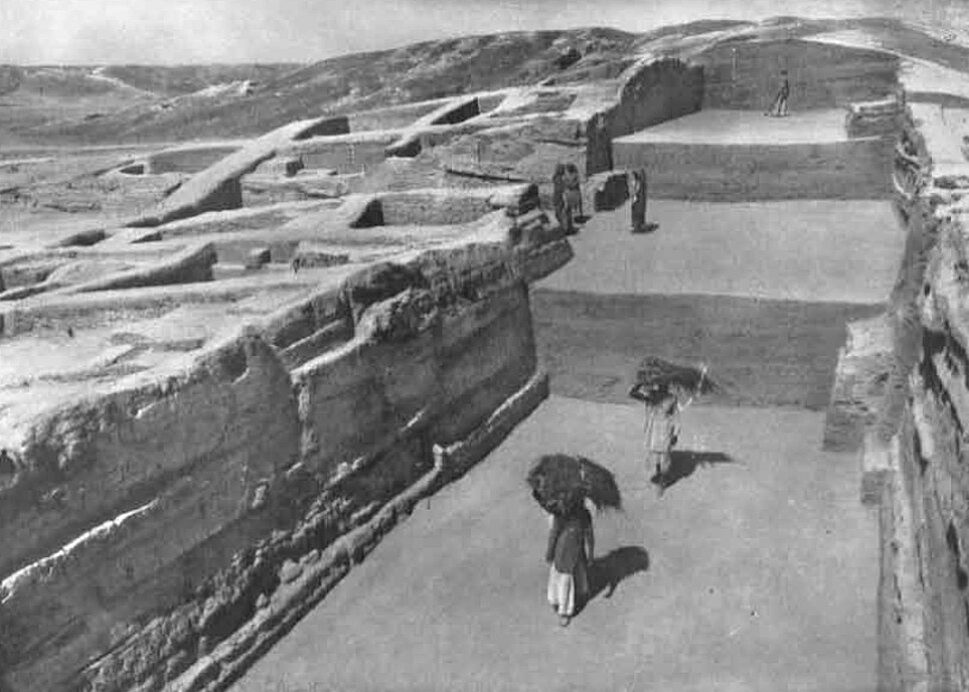
Two Mounds: Kalibangan consisted of two mounds:
- Citadel:
- Administrative and Religious Centre: The citadel mound was reserved for administrative functions and ritual practices. The fire altars located in the citadel suggest that this area was used for fire worship, with possible animal sacrifices.
- Fire Altars and Platforms: Within the citadel, raised platforms of mud bricks were separated by corridors, featuring fire pits made of burnt bricks. The presence of sacrificial posts and terracotta cakes points to significant ritual activities performed in the citadel.
- Lower Town – Residential Area:
- The lower town, which was also fortified, was the residential hub of Kalibangan, where common people lived.
- Houses were designed around a central courtyard, surrounded by 6–7 rooms, with direct access to at least two streets or lanes.
- Building Materials: Houses were constructed using mud bricks (size: 10 x 20 x 30 cm), while burnt bricks were used for structural elements like wells, drains, and door sills. Some floors were made of burnt tiles or terracotta cakes, and a few houses had tiled floors with geometrical designs.
- Grid-Based Layout: Kalibangan followed a grid pattern similar to other Indus Valley cities like Mohenjodaro and Harappa.
- Street Proportions:
- Roads and lanes had set ratios of widths. For example, the narrowest lanes measured 1.8 meters while the main streets reached up to 7.2 meters.
- Fender posts were installed at street corners to prevent accidents which shows their attention to safety.
Drainage and Water Management
- Sophisticated Drainage System: Kalibangan had an advanced drainage system, with covered drains connected to soakage jars beneath streets to manage waste and water. Some houses had their drains, emptying into the main street drainage.
- Wells and Water Storage: Many houses had private wells for water supply, made of burnt bricks for durability. This highlights Kalibangan’s advanced understanding of water management in an arid environment.
Architectural Features
- Uniform Brick Sizes: Both the fort walls and residential structures were built with uniform mud bricks (20 x 20 x 10 cm), demonstrating consistency in construction methods.
- Unique Housing Design: Houses typically feature a courtyard-centric design, with rooms on three sides of the courtyard. One notable feature was the presence of stairs, suggesting multi-story structures or access to rooftops.
Public and Private Spaces
- Well-Demarcated Public and Private Zones: The citadel served as the public and administrative zone, while the lower town was the private residential area.
Unique Discoveries at Kalibangan
One of Kalibangan’s most significant discoveries is the earliest known ploughed field, located southeast of the settlement, outside the town walls. Excavated around 2800 BCE, this agricultural field shows a clear grid of furrows, demonstrating advanced farming practices with a dual-crop system. The furrows, running both north-south and east-west, are remarkably similar to modern agricultural practices in the region, particularly the cultivation of mustard and gram.
The discovery of fire altars—unique to Kalibangan and Lothal—suggests ritualistic fire worship, marking the city’s religious and cultural significance. These fire pits, constructed with burnt bricks and equipped with sacrificial posts, were found in the citadel and lower town, as well as in a separate ritual area. No evidence of the mother goddess worship, typical of other Harappan sites, has been found here, indicating unique religious practices.
Pottery and Artifacts
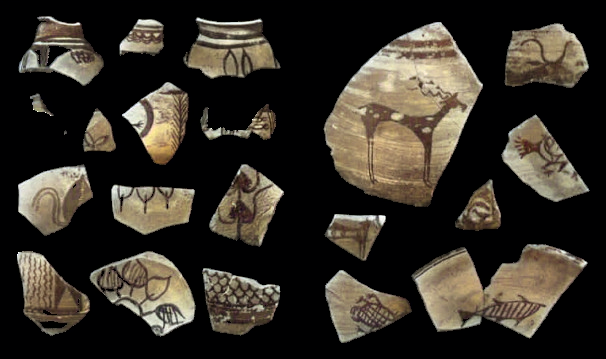
1. Pottery at Kalibangan
- The pottery found at Kalibangan is divided into six distinct fabrics, each offering a unique design.
- Fabric A:
- Redware with light-black designs, often decorated with white lines.
- Common motifs include lines, semicircles, grids, insects, flowers, leaves, and trees.
- Pottery was crafted carelessly but adorned with intricate designs.
- Fabric B:
- Marked improvement in craftsmanship, with the lower half deliberately roughened.
- Featured black-painted flowers and animals on a red background.
- Fabric C:
- A violet-tinged pottery is considered the finest proto-Harappan pottery.
- Thicker, polished, and adorned with black designs.
- Fabric D:
- Redware with plain pots and some designs featuring slanted lines or semicircles.
- Fabric E:
- Lighter coloured pottery, adds diversity to the pottery styles.
- Fabric F:
- Greyware, distinct from redware, represents another functional category of pottery.
- Fabric A:
- Pottery styles also included a range of forms for different purposes:
- Household Pots: Used in daily life for cooking, storage, and serving.
- Religious or Ritual Pottery: Some pots were used in fire altars for ritualistic purposes, especially during the Mature Harappan phase.
- Burial Pottery: Pottery was also found in burial contexts, often placed with the deceased as part of funerary practices.
2. Terracotta Artifacts
- Terracotta figurines and objects are abundant at Kalibangan, highlighting the everyday and ritualistic life of its people.
- Charging Bull Figurine: One of the finest terracotta pieces found, this artefact exemplifies the powerful and realistic art style of the Harappan Age.
- Toy Carts and Wheels: Small terracotta toys, such as carts, indicate the use of carts for transportation, as well as the importance of toys in daily life.
- Terracotta Bangles: Numerous bangles were discovered, leading to the name “Kalibangan,” which means “black bangles.”
3. Beads, Bangles, and Ornaments
- A variety of personal adornments were uncovered, made from different materials:
- Steatite, shell, carnelian, and copper beads: Indicate trade links and the variety of materials used in jewellery.
- Copper and shell bangles: Suggest the people’s preference for ornamentation and craftsmanship in these materials.
- Terracotta jewellery: Various items made of terracotta, including bangles and figurines, reveal local craftsmanship.
4. Tools and Weapons
- Stone tools made of chalcedony and agate, including blades, sometimes serrated, were common at the site.
- Copper tools, such as celts (axes), suggest the use of metalworking for practical and possibly ceremonial purposes.
- Querns and Mullers: Tools for grinding grains, providing evidence of the agricultural economy.
5. Seals
- Several Harappan seals were uncovered, most notably a cylindrical seal depicting a female figure between two male figures, possibly engaged in a conflict. These seals were likely used for trade or administrative purposes and also reflected the artistic and symbolic expressions of the people.
6. Burial Goods
- In the burial grounds at Kalibangan, pottery and other funerary objects such as mirrors, beads, and shell items were found buried with the deceased. These items provide insights into the burial rituals and the importance of accompanying objects in the afterlife.
- The discovery of symbolic burials (without skeletal remains) suggests unique funerary practices that differ from other Indus Valley sites.
7. Fire Altars
- Fire altars at Kalibangan indicate a ritualistic use of fire, possibly for religious worship. The presence of burnt bricks and terracotta cakes in these altars further emphasizes the ceremonial aspects of the site.
Burial Practices
Types of Burials: At Kalibangan, archaeologists uncovered three distinct types of burial practices:
- Extended Burials:
- In this method, the body was laid in a rectangular or oval pit with the corpse in an extended position, typically with the head pointing north.
- These pits were filled with pottery and other burial items, such as a copper mirror in one case.
- Symbolic Burials (Pot Burials):
- Symbolic burials consisted of an urn (a large pot) placed in a circular pit with no skeletal remains.
- Around the urn, 4 to 29 smaller pots and utensils were placed, possibly as offerings or to represent the deceased’s possessions.
- Grave Pits Without Corpses:
- Similar to the symbolic burials, rectangular or oval pits were found containing only pottery and funerary objects, but no human remains.
- These symbolic graves, which are not common in other Harappan cities, could represent memorials for individuals who may not have been physically buried at the site.
Grave Goods
- Pottery:
- Many burial pits, both with and without skeletal remains, were filled with pottery items, often undecorated, indicating their utilitarian nature. Some pots bore Harappan inscriptions, though they remain undeciphered.
- Personal Items:
- Items like copper mirrors, beads, and shell ornaments were found in the graves, reflecting the social or economic status of the deceased and their personal belongings.
- The presence of jewellery and tools in graves indicates the Harappan belief that these items would be required in the afterlife.
Anomalies and Unique Finds
- Skull with Holes:
- One of the more unusual findings was a child’s skull with six holes, suggesting either a medical procedure or ritualistic practice. This indicates the possibility of a cultural or health-related significance that is yet to be fully understood.
Comparison with Other Harappan Sites
- The burial practices at Kalibangan, especially the presence of symbolic burials, differ from other Harappan cities like Mohenjo-Daro and Harappa, where extended burials are more common.
- The use of pot burials without bodies is a distinctive feature of Kalibangan, offering a glimpse into the regional variations in funerary traditions within the broader Indus Valley Civilization.
Earthquakes at Kalibangan
Kalibangan, a key site of the Indus Valley Civilization, provides significant archaeological evidence of natural disasters, particularly earthquakes.
The Earliest Recorded Earthquake
- Kalibangan is notable for presenting one of the earliest archaeologically recorded earthquakes in history. Around 2600 BCE, a devastating earthquake is believed to have brought an abrupt end to the Early Harappan Phase at the site.
- According to B.B. Lal, the former Director General of the Archaeological Survey of India (ASI), this earthquake caused significant destruction to the early structures and contributed to the abandonment of the settlement before it was reoccupied during the Mature Harappan Phase.
Structural Damage
- Evidence of the earthquake is seen in the collapsed fortifications and damaged buildings at Kalibangan. Walls of mud brick structures were displaced or cracked, indicative of seismic activity.
- The settlement shows signs of hasty repairs and rebuilding after the earthquake, but these efforts were short-lived, as the city was soon abandoned.
Impact on the Early Harappan Settlement
- The earthquake caused significant destruction to the early structures and interrupted the continuous development of the city. The fortifications and housing structures of the citadel and lower town show clear signs of seismic damage.
- The earthquake was so severe that the settlement was temporarily abandoned after the event. However, after a brief period, the site was reoccupied by the Mature Harappans, who rebuilt the city with improved architectural techniques.
Seismic Activity in the Region
- The earthquake at Kalibangan is part of a broader pattern of seismic activity in the Indus Valley region during the period of the Indus Valley Civilization. Other sites like Dholavira also experienced earthquakes during this era, indicating that seismic instability may have been a recurring challenge for these ancient settlements.
- The presence of multiple seismic events during the period suggests that earthquakes may have contributed to the decline of several Indus Valley cities.
Reconstruction and Abandonment
- Following the earthquake, efforts were made to reconstruct parts of the city, including the fort walls and some houses. The settlement’s layout in the Mature Harappan Phase shows a return to planned urban development, but the damage caused by the earthquake left a lasting impact on the region.
- Despite these reconstruction efforts, Kalibangan, like many other Harappan cities, was eventually abandoned. One theory is that the drying up of the Sarasvati River (Ghaggar-Hakra), along with seismic instability, made it unsustainable for continued habitation
Decline and Abandonment
Kalibangan, like many other Harappan cities, eventually faced abandonment. Robert Raikes, an Italian hydrologist, and B.B. Lal, former Director-General of ASI, suggested that the drying up of the Sarasvati River likely caused the decline of Kalibangan. Radiocarbon dating places the end of the Mature Harappan settlement around 2650 BCE, correlating with evidence of river desiccation.

